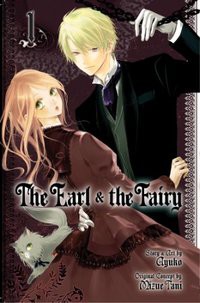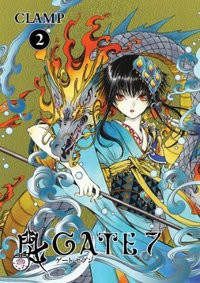RIGHT TURN ONLY!!
Hacking to the Gate
by Carlo Santos,

There I sat, completely stunned, wondering what had just happened in the final episode of Guilty Crown.
Then I reminded myself the new anime season starts in a week, so what the heck, I'll just conveniently forget everything and look forward to new stuff. Hooray!
A BRIDE'S STORY

Vol. 3
(by Kaoru Mori, Yen Press, $16.99)
FROM THE BACK COVER:
"A young widow, Talas opens her home to the researcher Mr. Smith, who has ventured to her town to continue his studies. However, when Talas's uncle begins to see Smith as an impediment to his plans to wed his son to Talas, the old man's schemes land the Englishman in prison! Far from friends and even farther from home, Smith's outlook seems grim..."
EVIDENCE FOR:
There's a new main character in A Bride's Story, but the storyline and setting are still just as good, if not better. With "awkward foreign guy" Smith taking the lead role, this chronicle of daily life suddenly becomes a lot more exciting: he's a stranger trying to survive in a strange land, hoping to make the journey to Ankara, and he happens to fall in love with a local girl while passing through a whistle-stop town. That pretty much negates all the complaints about nothing ever happening in this series. The romance between Talas and Mr. Smith is the true centerpiece of this volume: subtle and sweet in the opening chapters, building up to a clash of cultures and personalities, and finally arriving at a gut-punch ending that reminds us how unpredictable life can be. A couple of surprising subplots and returning characters also add variety to the story. The artwork remains rich and detailed as ever—who else takes the time to draw anatomically correct sheep?—and the change of locale from Volumes 1 and 2 means new outfits to marvel at, townscapes full of life, and an introduction to mouth-watering local cuisine. This fascinating, educational journey continues.
EVIDENCE AGAINST:
With everything that's going on, it's almost as if Kaoru Mori is overcompensating for the lack of action in the earlier parts of A Bride's Story. The romance between Smith and Talas gets things off to a good start, but then it just gets messy: there's a sudden arrest by the local police, a bunch of other characters show up, and an impromptu banquet is tacked on as filler. While these events do play a role in Mr. Smith's saga, they also end up overshadowing what the story arc was originally about. Maybe that's why, when we get to the final decision about Talas' marriage, it feels entirely too sudden—like Mori slamming on the brakes after realizing things were swerving out of control. Given Mori's reputation for slow, gentle pacing, the shock factor and all the angry yelling in the closing chapters feels very out of place. And even with all this action going on, there are still some boring moments, like the side characters talking about what they're going to eat. The straight, rectangular panel layouts on every page also start to look dull after a while.
FINAL VERDICT:
Even though some aspects of the story get messy, the ups and downs of Mr. Smith's travels—and the gorgeous artwork—are good enough for a B.
THE EARL AND THE FAIRY

Vol. 1
(by Ayuko, original concept by Mizue Tani, Viz Media, $9.99)
FROM THE BACK COVER:
"Edgar Ashenbert claims to be descended from the human ruler of the fairy kingdom, and he urgently needs Lydia's help to find and claim his birthright, the legendary sword of the Blue Knight Earl. Things will never be the same for Lydia as she is pulled into a dangerous quest against dark forces!"
EVIDENCE FOR:
Part of The Earl and the Fairy's appeal is simply being there: the elegant, otherworldly aura of its Victorian setting. Impeccably dressed characters and adventurous locations will catch the eye, while the combination of 19th-century mystery and British Isles folklore provide a unique theme to work with. The legend of the Earl and his sword, fictional as it may be, adds depth to the back-story—a sense that Edgar and Lydia are part of a greater quest rather than just romping around Great Britain. Readers will also be drawn into the way the plot darts and weaves in various directions: Lydia's about to take a journey on a ship, then she's on another ship, and then she and Edgar are trying to survive the countryside, all the while trying to figure out if she's teamed up with a hero or a villain. Who can resist twists and turns like that? The artwork, although crafted with delicate lines and subtle gradients, also shows boldness in the action scenes where Edgar and his servants fight off the thugs who are after him. It may be polite-and-proper England, but there's room for hot-blooded battle, too.
EVIDENCE AGAINST:
Not as intense as Black Butler, not as nuanced as Emma—it's like The Earl and the Fairy jumped on the historical England bandwagon and aimed directly down the middle, so that nothing about it stands out. It even has "fairy" in the title, yet there are no fairy-type characters playing a major role, unless you count the magical cat who isn't really a cat. But it isn't just the concept that feels lackluster: the main character, Lydia, also fails to make a strong impact in the story. Somehow, she spends more time being whisked from one place to another by strange men, rather than taking charge of her own fate. How is anyone supposed to root for a character like that? The attempts at romance between her and Edgar are also hard to believe—there's barely any chemistry, but they're the lead characters of opposite gender, so let's pair them up anyway. The real weakness, however, is in the art: many of the scenes are drawn with either no backgrounds, or a generic screentone substituting for a background. The bland character designs and ambiguous action shots don't help either, creating more confusion than mystery.
FINAL VERDICT:
It's easy to like the Victorian setting and constantly moving plot, but weak artwork and a lead character who barely even takes the lead average it out to a C.
GATE 7

Vol. 2
(by CLAMP, Dark Horse, $10.99)
FROM THE BACK COVER:
"A strange dimension overlaps with our reality, sending magical creatures and bloodthirsty spell casters against Hana and her team of Earth's protectors. As the newest member in Hana's strange group, awkward high schooler Chikahito Takamoto is looked upon with puzzlement and suspicion. His teammates have no idea how he can be immune to their special powers, and they wonder if Chikahito has any latent powers of his own. Finding himself in the middle of a high-stakes mystical war, Chikahito tries to make sense of the quirky, moody allies he's found himself aligned with and his own feelings for Hana—a strong, short, and awfully cute warrior!"
EVIDENCE FOR:
CLAMP's elaborate style of fantasy is as strong as ever in the second volume of Gate 7—and now that the basic idea has been laid out (famous Japanese historical figures reincarnated in the present day), it's time for some real battle. The first chapter unleashes some incredible feats of sorcery, combining the near-abstract artwork that was mastered in Tsubasa with principles of traditional magic and creature-summoning. As a result, we get a spell war that looks unlike any other, where sweeping lines and curves project not only an image of power, but also beauty and mystery. Then there's the martial-arts showdown in the final chapter—a more down-to-earth fight, but still full of the graceful, fluid motion that typifies CLAMP's work. The story, too, starts to pick up as new characters are introduced: if you've ever been a fan of historical titles like Sengoku Basara, then this is the perfect complement, the way it name-drops all these famous Edo-period generals and reimagines them as spell-wielding mystics, bratty teens, or even a kindergarten teacher. The ultimate battle may be ways off, but why worry when it's so much fun seeing all these great warriors meet?
EVIDENCE AGAINST:
Remember those infuriating middle-to-late volumes of Tsubasa when everything got weird, and CLAMP was being incomprehensible on purpose? It looks like it's happening here, too: strange names and ominous monsters are always mentioned, but never explained, and when new characters show up and start acting antagonistic, it's hard to understand why. Just as bad as a lack of information, however, is when the story tries to overload you with it: in every chapter, there's at least one scene where the characters start talking strategy about evil general Nobunaga and an all-powerful oni that the bad guys are trying to resurrect. But laying all those ideas out there without context or purpose doesn't clarify anything—it just reminds everyone there's a big bad boss lurking in the background. And what about the main cast of characters? Chika might as well forget about wearing the label of protagonist, the way he stands back as an observer most of the time. This is the guy with a special power ... and instead it's the supporting cast showing off their powers? This story needs to get its priorities sorted out.
FINAL VERDICT:
The art is top-notch, and the concept is fascinating for history buffs, but until the story straightens itself out, it's about B- material right now.
SLAM DUNK

Vol. 21
(by Takehiko Inoue, Viz Media, $9.99)
FROM THE BACK COVER:
"It's do or die for the Shohoku High School Basketball Team! If they want a spot in the Nationals, they need to win this game. As the second half winds down, Shohoku hangs on to a one-point lead over Ryonan despite Mitsui's collapse. Ryonan keeps the pressure on with their best players, Uozumi, Fukuda and Sendoh, giving it all they've got. Sakuragi steps up defensively, and now he's Shohoku's last hope of staying alive in the tournament, but is he up to the challenge?"
EVIDENCE FOR:
In real basketball, the final minute can take forever to finish, but the Shohoku-Ryonan game in Slam Dunk ends with as much excitement as any other matchup in the series. This volume's crowning glory is the nearly-wordless chapter showing the closing moments of the game; the action and emotion on the court come across so effectively that any dialogue would only get in the way. Yet even during ordinary game action with the players calling out to each other, the visuals still shine—perfectly posed jump shots and mid-air moves, the unique angles a real-life camera could never get to, and intense facial close-ups that remind us of the game's personal side. Speaking of the personal side, even minor characters get a chance to add something to the story: a sideline spectactor provides a boost of encouragement, a second-string player comes out of nowhere to deliver a dramatic John Paxson moment, and potential future opponents make their first appearance in unforgettable, rim-rattling fashion (say hello to the Japanese high school equivalent of Shaquille O'Neal). Between the basketball heroics and striking characters, Slam Dunk continues to be a standout in the sports genre.
EVIDENCE AGAINST:
Yes, the Shohoku-Ryonan game reaches a strong, drama-filled ending, but the story still trips up in a couple of areas. When bespectacled bench-warmer Kogure gets his moment in the spotlight, he becomes the subject of yet another sentimental flashback—one that goes by too quickly. So much for trying to flesh out that character. In addition, Sakuragi's emergence as a defensive star also feels contrived: he just keeps popping up in the right place at the right time, which makes it appear as if dumb luck is more important than hard work and determination. Perhaps the intent was to show Sakuragi's "defensive instincts," but it doesn't quite come across that way. Then comes a lull in the action as the second half of the book turns toward preparation for the national tournament. Although some downtime after a big game is understandable, the storyline drifts aimlessly, focusing on various characters but never pointing in a specific direction. That lack of momentum turns these chapters into mere filler as we wait for the next tournament to get started.
FINAL VERDICT:
Even if the story progression is less than perfect, the thrill of the game and the solid artistry are enough to earn this volume a B+.
TWIN SPICA

Vol. 12
(by Kou Yaginuma, Vertical, $13.95)
FROM THE BACK COVER:
"Graduation looms for what is left of the Tokyo Space School's first class. As the teens focus on their final days in school, many of them take the opportunity to finally share some long hidden feelings and settle a few differences. And finally, Japan's first student astronaut is selected! Will Asumi finally be able to drive the rocket of her childhood dreams?"
EVIDENCE FOR:
It's almost too easy for a long-running series to mess up the ending: unresolved subplots, sudden personality changes, cheap deus ex machina resolutions. But Twin Spica's finale makes none of these mistakes—instead, it's a litany of goodbyes, graduations, and new beginnings that conclude this coming-of-age saga perfectly. Predictably enough, Asumi accomplishes all her dreams, but even as a textbook happy ending it still delivers a powerful emotional punch. The other characters' storylines are neatly wrapped up as well—Kei, Marika and Fuchuya all reach new goals that suit their personalities well. These chapters also glimpse backward and forward, flashing back to Asumi's childhood and school years, then jumping a few months ahead to show how far everyone has come. That is the magic of the journey from adolescence to adulthood. The artwork also lends itself to the story's gentle, heartwarming nature: lots of silent panels, soft shading, and simple but appealing character designs. Let's not forget those incredible two-page spreads either, showing off the grandness of the universe while remaining connected to the characters' personal thoughts. Funny how a story about a humble, pint-sized student could teach us to reach for our grandest dreams.
EVIDENCE AGAINST:
Far be it from me to criticize a near-perfect finale to an all-time great series ... but this 400-page tome could probably have been two-thirds the size, were it not for some odd plot detours. The train crash that ended Volume 11 leads into a continuation that doesn't live up to its dramatic potential—basically, everyone comes out fine and there's no heroic struggle or tragic aftermath. Then there's Marika's quest to get into a medical program: for all the talk about how difficult the entrance exam is, we never get to see how much she studies for it, and instead it jumps straight to the final result. For a series that's all about overcoming the odds, subplots like these ruin the concept by failing to demonstrate the characters' hard work. Several scenes of Asumi and friends hanging out and chatting could probably have been cut as well, since their idle conversation adds nothing to the story aside from connecting one scene to another. The artwork has its drawbacks too: the simple, abbreviated style makes it hard to express certain shades of emotion and makes some of the characters' gestures look clumsy.
FINAL VERDICT:
Even with the plot points that don't quite work out, everything else about the story is a satisfying, masterfully executed ending. That's an A.

UGLIES: SHAY'S STORY

(by Scott Westerfeld, Devin Grayson and Steven Cummings, Del Rey, $10.99)
FROM THE BACK COVER:
"Uglies told Tally Youngblood's version of life in Uglyville and the budding rebellion against the Specials. Now comes an exciting graphic novel revealing new adventures in the Uglies world—as seen through the eyes of Shay, Tally's rebellious best friend who's not afraid to break the rules, no matter the cost.
A few months shy of her sixteenth birthday, Shay eagerly awaits her turn to become a Pretty—a rite-of-passage operation called 'the Surge' that transforms ordinary Uglies into paragons of beauty. Yet after befriending the Crims, a group of fellow teens who refuse to take anything in society at face value, Shay starts to question the whole concept. And as the Crims explore beyond the monitored borders of Uglyville into the forbidden, ungoverned wild, Shay must choose between the perks of being Pretty and the rewards of being real."
EVIDENCE FOR:
Even those unfamiliar with the Uglies franchise (such as yours truly) will find themselves pulled into the action of Shay's Story, which pushes all the right science fiction buttons. An imaginative, dystopian world, a protagonist in conflict with herself and with others, a unique made-up vocabulary, and the eternal battle between individuality and conformity—it's got all the stuff that kids will love and grown-ups will relate to. Shay's adventures move at a quick, suspenseful pace, and her habit of constantly flouting the law means that there's always the tension of wondering whether this is the moment she gets caught. The unpredictable character relationships, where the lines between friend and enemy are constantly shifting, also create plenty of drama at the personal level. Just as gripping as the story is the artwork, with its instantly memorable character designs and a flair for dramatic angles that only improve with each successive chapter. The second half of the book, where Shay moves out to a frontier settlement to escape the authorities, is particularly impressive with its sweeping wilderness backgrounds and dynamic action scenes—the last of which leads into a perfectly timed cliffhanger.
EVIDENCE AGAINST:
Although the story moves at a quick pace, it hits some rough spots along the way, mostly by skimming over certain plot points. The relationship between Shay and bad-boy heartthrob David is particularly awkward: the story suddenly declares that she sort-of likes him (where did that come from?), and later on their mutual feelings get a quick two-page treatment before moving on to other things. The story's overall structure suffers as well, with stiff, abrupt transitions from one act to the next—one moment it's Shay running with the Crims, then suddenly they're gone and she meets Tally? It has all the earmarks of a writer trying to cram a complete young adult novel into 200 comic pages, which of course never works. The prose-novel influence can also be felt in Shay's preachy, predictable narration, where she goes on and on about the glory of being yourself and how horrible it is to be "fake." Then it gets even more sanctimonious when she and Tally have heated arguments on the exact same topic. Meanwhile, the artwork could stand to use fewer gray tones and more black-and-white contrast.
FINAL VERDICT:
Although the story rushes through some points and gets preachy at times, the constant action and confident artwork still make Shay's Story a great adventure.

What this column needs now is love, sweet love ... Boys' Love! The elusive, mysterious-sounding black mokona introduces us to a series that's a cut above what one might expect from the genre.
As always, Reader's Choice thrives on variety, so if there are other genres you think are getting overlooked, submit a review and open it up to the world!
SEVEN DAYS

(by Venio Tachibana and Rihito Takarai, Digital Manga Publishing, $12.95 print, $7.95 digital)
Seven Days caused a small sensation in the online community when it was first scanlated, and it rode that hype into publication. Fresh in each re-read, endlessly fascinating to look at, never lagging, never lapsing, this two-volume release tells a romance over seven days.
Upperclassman Shino Yuzuru sports a beautiful face that deceives many doe-eyed girls of his unkempt manner. He jokingly asks out his popular junior, Seryou Touji, who always accepts a confession on Monday and dumps the girl at the end of the week. The premise leaves no room to the imagination as to where the story will go; of course they fall in love, of course they comment about loving people for who they truly are. Seven Days is a light, traditional, straight-up romance that never lost sight of what it wants to be and what story it wants to tell. Perhaps one of the few shounen-ai titles that offer little actual shounen-ai fan service.
Misunderstandings riddle their relationship, and is the initial driving force, though there is plenty of personality behind every advancement too. But it all happens in so short a span of time, they are allowed their confusion and inertia. There is a pre-existing sempai-kouhai relationship between the two, but without a hidden crush, without obvious dominant-submissive roles, and when it plays out, without the usual barriers in homosexual relationships. That is what I meant by Seven Days not surrendering to shounen-ai cliches, despite wallowing knee-deep in generic grounds. That they are both of the same gender does the only thing it's supposed to, lending legitimacy to the misunderstandings and creating equal footing between Shino and Seryou.
And what wonderful generic ground it is. Seven Days reminds us why drama and a love story still leave us breathless. Here are two adolescents: Shino doesn't know what he wants but knows to take happiness into his own hand, Seryou searches for love but doubts it's within reach when it arrives. They both get suddenly, irrationally jealous, act on impulses and show self-preservation. They enjoy a quiet dynamic that tugs at heart strings, compounded by the leisurely pacing and art. And Takarai does beautiful things with the human body, effortlessly showing every nuance of movement; indeed here is where Seven Days serves up fan service: "look, two hot boys doing intimate things with each other." Background is startlingly detailed for a shounen-ai series, and as it was my very first venture into the kind, I believe I had been horribly spoiled.
Is there a hidden gem of manga you'd like to reveal to the world? Is there a piece of garbage that deserves to be bashed in public? Or is there a title that didn't get a fair grade here, and you want to set the record straight?
Now's YOUR chance to be the reviewer! Write a review of about 300-400 words (a little more or less is fine) and include:
- Your name
- Title of manga (and volume no., if applicable)
- Author/Artist
- Publisher
- Briefly describe the story, then explain why this manga is great, terrible, or in between. Be objective, but also be entertaining.
Then send it in to rtoreaders (at) gmail (dot) com (plain text format preferred). One review will be selected out of all the submissions and will be published in the next column. All types of manga and manga-inspired comickry are accepted, from past and present, from Japan and beyond—what matters is that it's the Reader's Choice! NOTE: Submissions may be edited for formatting and grammar.
discuss this in the forum (6 posts) |